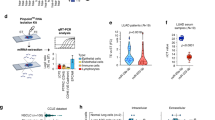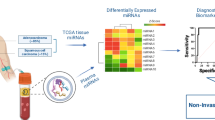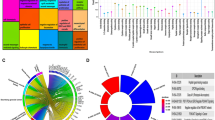Abstract
The c-Src kinase regulates cancer cell invasion through inhibitor of DNA binding/differentiation 1 (ID1). Src and ID1 are frequently overexpressed in human lung adenocarcinoma. The current study aimed at identifying microRNAs (miRNAs) involved in the Src-ID1 signaling in lung cancer. Incubation of lung cancer cells with the Src inhibitor saracatinib led to the upregulation of several miRNAs including miR-29b, which was the most highly upregulated miRNA with predicted binding to the ID1 3′-untranslated region (UTR). Luciferase reporter assays confirmed direct binding of miR-29b to the ID1 3′-UTR. Expression of miR-29b suppressed ID1 levels and significantly reduced migration and invasion. Expression of antisense-miR-29b (anti-miR-29b), on the other hand, enhanced ID1 mRNA and protein levels, and significantly increased lung cancer cell migration and invasion, a hallmark of the Src-ID1 pathway. The ectopic expression of ID1 in miR-29b-overexpressing cells was able to rescue the migratory potential of these cells. Both, anti-miR-29b and ID1 overexpression diminished the effects of the Src inhibitors saracatinib and dasatinib on migration and invasion. Saracatinib and dasatinib decreased c-Myc transcriptional repression on miR-29b and led to increased ID1 protein levels, whereas forced expression of c-Myc repressed miR-29b and induced ID1. In agreement, we showed direct recruitment of c-Myc to the miR-29b promoter. miR-29b was significantly downregulated in primary lung adenocarcinoma samples compared with matched alveolar lung tissue, and miR-29b expression was a significant prognostic factor for patient outcome. These results suggest that miR-29b is involved in the Src-ID1 signaling pathway, is dysregulated in lung adenocarcinoma and is a potential predictive marker for Src kinase inhibitors.
This is a preview of subscription content, access via your institution
Access options
Subscribe to this journal
Receive 50 print issues and online access
$259.00 per year
only $5.18 per issue
Buy this article
- Purchase on SpringerLink
- Instant access to full article PDF
Prices may be subject to local taxes which are calculated during checkout








Similar content being viewed by others
References
Albini A, Benelli R . (2007). The chemoinvasion assay: a method to assess tumor and endothelial cell invasion and its modulation. Nat Protoc 2: 504–511.
Bishop JA, Benjamin H, Cholakh H, Chajut A, Clark DP, Westra WH . (2010). Accurate classification of non-small cell lung carcinoma using a novel microRNA-based approach. Clin Cancer Res 16: 610–619.
Caldas C, Brenton JD . (2005). Sizing up miRNAs as cancer genes. Nat Med 11: 712–714.
Calin GA, Croce CM . (2006). MicroRNA-cancer connection: the beginning of a new tale. Cancer Res 66: 7390–7394.
Calin GA, Ferracin M, Cimmino A, Di Leva G, Shimizu M, Wojcik SE et al. (2005). A MicroRNA signature associated with prognosis and progression in chronic lymphocytic leukemia. N Engl J Med 353: 1793–1801.
Calin GA, Sevignani C, Dumitru CD, Hyslop T, Noch E, Yendamuri S et al. (2004). Human microRNA genes are frequently located at fragile sites and genomic regions involved in cancers. Proc Natl Acad Sci U S A 101: 2999–3004.
Chang TC, Yu D, Lee YS, Wentzel EA, Arking DE, West KM et al. (2008a). Widespread microRNA repression by Myc contributes to tumorigenesis. Nat Genet 40: 43–50.
Chang YM, Bai L, Liu S, Yang JC, Kung HJ, Evans CP . (2008b). Src family kinase oncogenic potential and pathways in prostate cancer as revealed by AZD0530. Oncogene 27: 6365–6375.
Croce CM . (2009). Causes and consequences of microRNA dysregulation in cancer. Nat Rev Genet 10: 704–714.
Fabbri M, Garzon R, Cimmino A, Liu Z, Zanesi N, Callegari E et al. (2007). MicroRNA-29 family reverts aberrant methylation in lung cancer by targeting DNA methyltransferases 3A and 3B. Proc Natl Acad Sci U S A 104: 15805–15810.
Fong S, Debs RJ, Desprez PY . (2004). Id genes and proteins as promising targets in cancer therapy. Trends Mol Med 10: 387–392.
Garzon R, Garofalo M, Martelli MP, Briesewitz R, Wang L, Fernandez-Cymering C et al. (2008). Distinctive microRNA signature of acute myeloid leukemia bearing cytoplasmic mutated nucleophosmin. Proc Natl Acad Sci U S A 105: 3945–3950.
Gautschi O, Tepper CG, Purnell PR, Izumiya Y, Evans CP, Green TP et al. (2008). Regulation of Id1 expression by SRC: implications for targeting of the bone morphogenetic protein pathway in cancer. Cancer Res 68: 2250–2258.
Gebäck T, Schulz MM, Koumoutsakos P, Detmar M . (2009). TScratch: a novel and simple software tool for automated analysis of monolayer wound healing assays. Biotechniques 46: 265–274.
Griffiths-Jones S, Grocock RJ, van Dongen S, Bateman A, Enright AJ . (2006). miRBase: microRNA sequences, targets and gene nomenclature. Nucleic Acids Res 34: D140–D144.
Guo H, Ingolia NT, Weissman JS, Bartel DP . (2010). Mammalian microRNAs predominantly act to decrease target mRNA levels. Nature 466: 835–840.
Iorio MV, Ferracin M, Liu CG, Veronese A, Spizzo R, Sabbioni S et al. (2005). MicroRNA gene expression deregulation in human breast cancer. Cancer Res 65: 7065–7070.
John B, Enright AJ, Aravin A, Tuschl T, Sander C, Marks DS . (2004). Human MicroRNA targets. PLoS Biol 2: e363.
Johnson FM, Bekele BN, Feng L, Wistuba I, Tang XM, Tran HT et al. (2010). Phase II study of dasatinib in patients with advanced non-small-cell lung cancer. J Clin Oncol 28: 4609–4615.
Kaeser MD, Iggo RD . (2002). Chromatin immunoprecipitation analysis fails to support the latency model for regulation of p53 DNA binding activity in vivo. Proc Natl Acad Sci U S A 99: 95–100.
Krek A, Grun D, Poy MN, Wolf R, Rosenberg L, Epstein EJ et al. (2005). Combinatorial microRNA target predictions. Nat Genet 37: 495–500.
Langenfeld EM, Calvano SE, Abou-Nukta F, Lowry SF, Amenta P, Langenfeld J . (2003). The mature bone morphogenetic protein-2 is aberrantly expressed in non-small cell lung carcinomas and stimulates tumor growth of A549 cells. Carcinogenesis 24: 1445–1454.
Lasorella A, Uo T, Iavarone A . (2001). Id proteins at the cross-road of development and cancer. Oncogene 20: 8326–8333.
Lebanony D, Benjamin H, Gilad S, Ezagouri M, Dov A, Ashkenazi K et al. (2009). Diagnostic assay based on hsa-miR-205 expression distinguishes squamous from nonsquamous non-small-cell lung carcinoma. J Clin Oncol 27: 2030–2037.
Leighl NB, Paz-Ares L, Douillard JY, Peschel C, Arnold A, Depierre A et al. (2005). Randomized phase III study of matrix metalloproteinase inhibitor BMS-275291 in combination with paclitaxel and carboplatin in advanced non-small-cell lung cancer: National Cancer Institute of Canada-Clinical Trials Group Study BR 18. J Clin Oncol 23: 2831–2839.
Lewis BP, Burge CB, Bartel DP . (2005). Conserved seed pairing, often flanked by adenosines, indicates that thousands of human genes are microRNA targets. Cell 120: 15–20.
Livak KJ, Schmittgen TD . (2001). Analysis of relative gene expression data using real-time quantitative PCR and the 2(-Delta Delta C(T)) Method. Methods 25: 402–408.
Lyden D, Young AZ, Zagzag D, Yan W, Gerald W, O'Reilly R et al. (1999). Id1 and Id3 are required for neurogenesis, angiogenesis and vascularization of tumour xenografts. Nature 401: 670–677.
McCarty Jr KS, Miller LS, Cox EB, Konrath J, McCarty Sr KS . (1985). Estrogen receptor analyses. Correlation of biochemical and immunohistochemical methods using monoclonal antireceptor antibodies. Arch Pathol Lab Med 109: 716–721.
Mitra SK, Schlaepfer DD . (2006). Integrin-regulated FAK-Src signaling in normal and cancer cells. Curr Opin Cell Biol 18: 516–523.
Mott JL, Kobayashi S, Bronk SF, Gores GJ . (2007). mir-29 regulates Mcl-1 protein expression and apoptosis. Oncogene 26: 6133–6140.
Mott JL, Kurita S, Cazanave SC, Bronk SF, Werneburg NW, Fernandez-Zapico ME . (2010). Transcriptional suppression of mir-29b-1/mir-29a promoter by c-Myc, hedgehog, and NF-kappaB. J Cell Biochem 110: 1155–1164.
Muniyappa MK, Dowling P, Henry M, Meleady P, Doolan P, Gammell P et al. (2009). MiRNA-29a regulates the expression of numerous proteins and reduces the invasiveness and proliferation of human carcinoma cell lines. Eur J Cancer 45: 3104–3118.
Oberli A, Popovici V, Delorenzi M, Baltzer A, Antonov J, Matthey S et al. (2008). Expression profiling with RNA from formalin-fixed, paraffin-embedded material. BMC Med Genomics 1: 9.
Patnaik SK, Kannisto E, Knudsen S, Yendamuri S . (2010). Evaluation of microRNA expression profiles that may predict recurrence of localized stage I non-small cell lung cancer after surgical resection. Cancer Res 70: 36–45.
Pekarsky Y, Santanam U, Cimmino A, Palamarchuk A, Efanov A, Maximov V et al. (2006). Tcl1 expression in chronic lymphocytic leukemia is regulated by miR-29 and miR-181. Cancer Res 66: 11590–11593.
Rothschild SI, Gautschi O, Haura EB, Johnson FM . (2010). Src inhibitors in lung cancer: current status and future directions. Clin Lung Cancer 11: 238–242.
Rothschild SI, Kappeler A, Ratschiller D, Betticher DC, Tschan MP, Gugger M et al. (2011). The stem cell gene “inhibitor of differentiation 1” (ID1) is frequently expressed in non-small cell lung cancer. Lung Cancer 71: 306–311.
Summy JM, Gallick GE . (2006). Treatment for advanced tumors: SRC reclaims center stage. Clin Cancer Res 12: 1398–1401.
Sun X, Li C, Zhuang C, Gilmore WC, Cobos E, Tao Y et al. (2009). Abl interactor 1 regulates Src-Id1-matrix metalloproteinase 9 axis and is required for invadopodia formation, extracellular matrix degradation and tumor growth of human breast cancer cells. Carcinogenesis 30: 2109–2116.
Swarbrick A, Akerfeldt MC, Lee CS, Sergio CM, Caldon CE, Hunter LJ et al. (2005). Regulation of cyclin expression and cell cycle progression in breast epithelial cells by the helix-loop-helix protein Id1. Oncogene 24: 381–389.
Takamizawa J, Konishi H, Yanagisawa K, Tomida S, Osada H, Endoh H et al. (2004). Reduced expression of the let-7 microRNAs in human lung cancers in association with shortened postoperative survival. Cancer Res 64: 3753–3756.
Tschan MP, Fischer KM, Fung VS, Pirnia F, Borner MM, Fey MF et al. (2003). Alternative splicing of the human cyclin D-binding Myb-like protein (hDMP1) yields a truncated protein isoform that alters macrophage differentiation patterns. J Biol Chem 278: 42750–42760.
Valencia-Sanchez MA, Liu J, Hannon GJ, Parker R . (2006). Control of translation and mRNA degradation by miRNAs and siRNAs. Genes Dev 20: 515–524.
Voortman J, Goto A, Mendiboure J, Sohn JJ, Schetter AJ, Saito M et al. (2010). MicroRNA expression and clinical outcomes in patients treated with adjuvant chemotherapy after complete resection of non-small cell lung carcinoma. Cancer Res 70: 8288–8298.
Wu X, Piper-Hunter MG, Crawford M, Nuovo GJ, Marsh CB, Otterson GA et al. (2009). MicroRNAs in the pathogenesis of Lung Cancer. J Thorac Oncol 4: 1028–1034.
Xu H, Cheung IY, Guo HF, Cheung NK . (2009). MicroRNA miR-29 modulates expression of immunoinhibitory molecule B7-H3: potential implications for immune based therapy of human solid tumors. Cancer Res 69: 6275–6281.
Yanaihara N, Caplen N, Bowman E, Seike M, Kumamoto K, Yi M et al. (2006). Unique microRNA molecular profiles in lung cancer diagnosis and prognosis. Cancer Cell 9: 189–198.
Yokota Y . (2001). Id and development. Oncogene 20: 8290–8298.
Yu SL, Chen HY, Chang GC, Chen CY, Chen HW, Singh S et al. (2008). MicroRNA signature predicts survival and relapse in lung cancer. Cancer Cell 13: 48–57.
Acknowledgements
Deborah Shan is gratefully acknowledged for excellent technical support. We acknowledge Dr John Minna (UT Southwestern, Medical Center, Dallas, TX, USA) and Dr Yitzhak Zimmer for providing us with cell lines. We thank Wieslawa Blank for support with Western blotting and Dr Daniel Betticher for providing us with primary tumors from the tumor tissue bank. We also thank Dr Jasmin Batliner for support with luciferase assays. We thank AstraZeneca (Manchester, UK) for providing saracatinib. This study was supported by Swiss Cancer League (Grant KLS 02164-02-2008 to OG and MG), the Bernese Cancer League (to MG, OG and MPT), the Werner and Hedy Berger-Janser Foundation of Cancer Research (to MFF and MPT), the Bernese Foundation of Cancer Research, the Marlies-Schwegler Foundation and the Ursula-Hecht-Foundation for Leukemia Research (to MFF).
Author information
Authors and Affiliations
Corresponding author
Ethics declarations
Competing interests
The authors declare no conflict of interest.
Additional information
Supplementary Information accompanies the paper on the Oncogene website
Rights and permissions
About this article
Cite this article
Rothschild, S., Tschan, M., Federzoni, E. et al. MicroRNA-29b is involved in the Src-ID1 signaling pathway and is dysregulated in human lung adenocarcinoma. Oncogene 31, 4221–4232 (2012). https://doi.org/10.1038/onc.2011.578
Received:
Revised:
Accepted:
Published:
Issue date:
DOI: https://doi.org/10.1038/onc.2011.578
Keywords
This article is cited by
-
Carcinogenicity of nicotine and signal pathways in cancer progression: a review
Environmental Chemistry Letters (2024)
-
Matrisome analysis of intrahepatic cholangiocarcinoma unveils a peculiar cancer-associated extracellular matrix structure
Clinical Proteomics (2019)
-
MiR-29c reduces the cisplatin resistance of non-small cell lung cancer cells by negatively regulating the PI3K/Akt pathway
Scientific Reports (2018)
-
The novel hsa-miR-12528 regulates tumourigenesis and metastasis through hypo-phosphorylation of AKT cascade by targeting IGF-1R in human lung cancer
Cell Death & Disease (2018)
-
MiR-760 suppresses non-small cell lung cancer proliferation and metastasis by targeting ROS1
Environmental Science and Pollution Research (2018)



